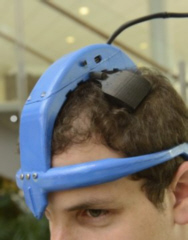.gif) VIARTIS � |
||||||||||||
| � |
�PARKINSON'S DISEASE NEWS |
� | ||||||||||
|
� � � � � |
Parkinson's Disease News covers all significant new research, reports, books, and resources concerning Parkinson's Disease. Articles are chosen on the basis of their medical significance or potential interest. Our overwhelming priority is the facts, regardless of whether they contradict prevailing views or vested interests. Analysis and further information are provided either to explain the background or implications, or to balance misleading claims. If you notice errors or inadequacies, or dispute what is written, or want to propose articles, please e-mail [email protected].
� 18th June�2015 - News release NONINVASIVE BRAIN STIMULATOR FOR PARKINSON'S DISEASE
John Hopkins University is developing a non-invasive brain stimulator, called Stimband, for the treatment of Parkinson's Disease. STIMband is a headband shaped device that is placed on the head. It does not require any surgery. For more information go to STIMband brain stimulator � For people in advanced stages of Parkinson's Disease, one treatment option is deep brain stimulation. In this procedure, a surgeon implants thin electrical leads into the region of the brain that controls movement. The leads are connected to a pulse generator, similar to a pacemaker for the heart, that is placed under the skin below the collarbone. This implant sends electrical signals to the brain to help curb symptoms caused by Parkinson's Disease. However, this procedure is really invasive and can take 10 to 15 hours to complete.
It is easy to put on, comfortable to wear and is positioned so that the electrodes remain stable and properly target the motor cortices areas of the brain. The inventors obtained provisional patents covering the design of the device, dubbed the STIMband. Another Johns Hopkins team is taking over the project in September to further enhance the design and move it closer to patient availability. One addition may be a wireless connection to allow a doctor to adjust a patient's treatment level from a remote location. For more news go to Parkinson's Disease News �
|
� � � � � � � � � � � � � � � |
||||||||||
.gif) |
||||||||||||
| � | ||||||||||||
| �2006-2015� Viartis | ||||||||||||
| � | ||||||||||||
| 2015-06-18 12:54:22 | ||||||||||||
| � | ||||||||||||
| [email protected] | ||||||||||||
 ��� �
��� �
 �����
�����
 �� ��
�� ��
 ����
����
 ��� �
��� �
 ����
����
 ����
����
 ����
����


 E-MAIL NOTIFICATION : If you would like to be
notified by e-mail when any new articles are added to Parkinson's Disease News,� please merely
e-mail
E-MAIL NOTIFICATION : If you would like to be
notified by e-mail when any new articles are added to Parkinson's Disease News,� please merely
e-mail
